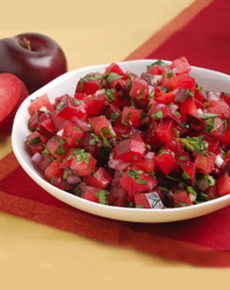|
Peach salsa is one of the best-selling salsa flavors.
You can make your own salsa with almost any seasonal fruit, including other stone fruits such as nectarines and plumcots, or your favorite berries. The fruit takes the place of the tomato, although you can also add a tomato in season.
Enjoy the result with chips or on meat, poultry, fish, seafood, eggs, tofu and all of the “usuals”—even vanilla or fruit ice cream/frozen yogurt and sorbet. Or, make easy cinnamon tortilla chips to go with it.
FRUIT SALSA RECIPE
This salsa recipe was shared by Melissas.com, using their now-in-season Flavorosa Plumcots.
Ingredients
1 tablespoon lime juice
2 teaspoons sugar or substitute
1 pound plumcots, diced
1/3 cup red onion, minced
1/2 cup cilantro, finely chopped
1/4 cup mint, finely chopped
1 teaspoon red jalapeño chile
Salt and white pepper to taste
|
|

Make salsa from your favorite fruit.
Plumcot photo salsa courtesy Melissas.com. |
|
Preparation
1. In small bowl, combine lime juice and sugar until sugar dissolves, making marinade.
2. In large bowl, combine all other ingredients, adding salt and pepper to taste.
3. Stir marinade into large bowl, blend and chill prior to serving.
Here’s another fruit salsa recipe: Strawberry Kiwi Cucumber Salsa With Easy Cinnamon Tortilla Chips.
What’s The Difference Between A Plumcot & A Pluot?
They’re all hybrids, meant to present the best qualities of both fruits—for the consumer, more sweetness and juiciness; for the seller, easier to grow, harvest, and ship. The names are trademarked by their respective breeders.
A plumcot is 50% plum/50% apricot. Developed by Luther Burbank in the 1920s, it is sweeter than either parent.
The pluot, also known as a “dinosaur egg” because of its speckled skin, was created by a California fruit breeder who wanted to improve on the plumcot. A pluot, sweeter than a plumcot, is primarily plum, with a range from 60% plum/40% apricot to 75% plum/25% apricot spanning more than 25 varieties. They have a higher sugar content and a more complex flavor profile than either a plum or an apricot. Because of the percentage of genes, it has the flavor of a plum but the mouthfeel of the apricot.
An aprium is the reverse of the pluot: a mix of 70% apricot/30% plum, though it can vary, as long as it is 60% apricot or more. It looks like an apricot, but is sweeter than either an apricot or a plum.
All three, like their parents, are low in fat and calories, but all that sweetness raises the carb content. The fruits are full of vitamin A and C and high in calcium, fiber, iron, magnesium and potassium.
|



